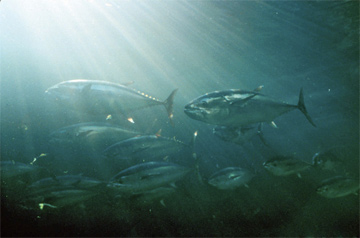Overfishing takes toll on Bluefin tuna
Overfishing takes toll on Bluefin tuna
mongabay.com
August 5, 2007
Overfishing has caused dramatic shifts in bluefin tuna populations that have pushed the species closer towards extinction in some areas, reports a series of studies by the Census of Marine Life (CoML) and other researchers.
In one study, published in Fisheries Research, Brian R. MacKenzie of the Technical University of Denmark and the late Ransom Myers of Dalhousie University in Canada use market records to trace the birth of the bluefin tuna fishery off Northern Europe to its collapse in the 1960s.
“We can’t say with certainty that over-exploitation is the smoking gun in the bluefin tuna’s disappearance — but clearly there’s been a murder,” said lead author Brian R. MacKenzie of the Technical University of Denmark. “We’ve shown bluefin tuna were here for a long time in high numbers. High fishing pressure preceded the species’ virtual disappearance from the area and apparently played a key role but other factors under study might have compounded the fishery’s demise — the catch of juvenile tuna in subsequent years, for example.”

Bluefin tuna. Courtesy of NOAA |
Today, the few tuna that persist in Northern European waters do so only for short periods, traveling great distances every year, according to another study, published in Hydrobiologia. Researchers Michael Stokesbury, Ronan Cosgrove, Andre Boustany, Daragh Browne, Steven L. H. Teo, Ron O’Dor and Barbara A. Block report that two tuna tagged within minutes of each other off western Ireland in 2003 and 2004 ended up more than 5,000 km apart eight months later. One traveled 6,000 km in 177 days to waters about 300 kilometers northeast of Cuba; while the other remained in the eastern Atlantic the coasts of Portugal. A third tagged fish swam was captured by fishermen in Malta in 2005.
“These tagging data potentially provides new evidence that mixing is occurring in the northern waters of the eastern Atlantic and complement prior data showing that the western and eastern stocks of north Atlantic bluefin mingle in rich foraging grounds of the central Atlantic,” said Stanford University’s Barbara Block, chief scientist of the CoML Tagging of Pacific Predators program and the Tag-A-Giant (TAG) program. “It’s possible all three fish were spawned in the Mediterranean. We’re conducting genetic tests on fin clips taken while tagging to help confirm the
origins of the specific bluefin tuna that we followed electronically.”
A third study, to be published in the journal Marine Biology, provides insight in habitat used by spawning bluefin tuna and offers hope that U.S. spawning stocks can someday be better protected. The spawning stock has dropped 90% in the past 30 years.
Tracking 28 tagged Atlantic bluefin, the authors — Steven L. H. Teo, Andre M. Boustany and Barbara Block — report that bluefin appear to spawn where
the slope of the shelf is steep and sea surface temperatures are 24 to 27 degrees Celsius. The scientists say that small changes in surface temperatures could cause shifts in the timing and location of spawning.
“We found that bluefin get warm when they undergo courtship and our physiological measurements indicate they are vulnerable to overheating while in the Gulf of Mexico,” said lead author Dr. Steven Teo of Stanford University. “The bluefin showed a preference for regions of the Gulf of Mexico — information that can help map where they spawn.”
“Together these new reports help define where bluefin spawn and provide evidence for their trans-oceanic migrations. A fisherman from the Scandinavian Tuna Club might have chased the same giant bluefin as a Cuban fisherman,” said Dalhousie University’s Dr. O’Dor, a senior scientist from the Census of Marine Life. “Part of the lesson here is that restoring bluefin tuna populations to health requires us to consider and manage activities one-fifth of the way around the world.”
Bluefin tuna, which spawn in the Gulf of Mexico and the Mediterranean and are among the ocean’s top predators, are sometimes called the “Porsche of the Oceans” says Mike Sutton from the Monterey Bay Aquarium, one of the institutions that sponsored the research.
“We call it the “Porsche of the Oceans” because the bluefin tuna is the size of a Porsche, 10 feet long and a 1500-pound upper size limit; it as fast as a Porsche, 0 to 60 in 5 seconds; and they are as valuable as a Porsche, 100 grand,” said Sutton in an interview with mongabay.com. “The Bluefin tuna is really the poster child of overfishing.”
Related
An interview with the Monterey Bay Aquarium’s Mike Sutton:
How to save the world’s oceans from overfishing
(07/09/2007) Global fishing stocks are in trouble. After expanding from 18 millions tons in 1950 to around 94 million tons in 2000, annual world fish catch has leveled off and may even be declining. Scientists estimate that the number of large predatory fish in the oceans has fallen by 90 percent since the 1950s, while about one-quarter of the world’s fisheries are overexploited, depleted, or recovering from depletion. Despite these dire trends, the situation is changing. Today some of the world’s largest environmental groups are focused on addressing the health of marine life and oceans, while sustainable fisheries management is at the top of the agenda for intergovenmental bodies. At the forefront of these efforts is Mike Sutton, director of the Monterey Bay Aquarium’s conservation program: the Center for the Future of the Oceans. The aquarium, which has long been recognized as one of the world’s most important marine research facilities, is pioneering new strategies for protecting the planet’s oceans. Sutton says the approach has four parts: establishing new marine protected areas, pushing for ocean policy reform, promoting sustainable seafood, and protecting wildlife and marine ecosystems.
This article is based on a news release from CoML